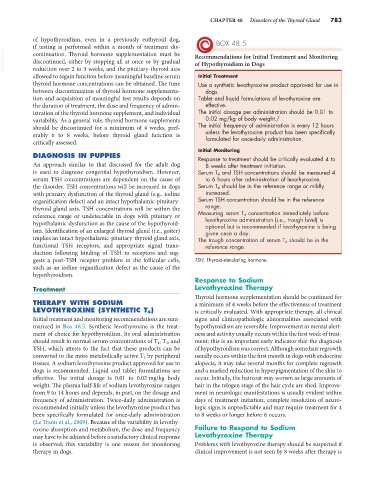Page 811 - Small Animal Internal Medicine, 6th Edition
P. 811
CHAPTER 48 Disorders of the Thyroid Gland 783
of hypothyroidism, even in a previously euthyroid dog,
if testing is performed within a month of treatment dis- BOX 48.5
VetBooks.ir continuation. Thyroid hormone supplementation must be Recommendations for Initial Treatment and Monitoring
discontinued, either by stopping all at once or by gradual
of Hypothyroidism in Dogs
reduction over 2 to 3 weeks, and the pituitary-thyroid axis
allowed to regain function before meaningful baseline serum Initial Treatment
thyroid hormone concentrations can be obtained. The time Use a synthetic levothyroxine product approved for use in
between discontinuation of thyroid hormone supplementa- dogs.
tion and acquisition of meaningful test results depends on Tablet and liquid formulations of levothyroxine are
the duration of treatment, the dose and frequency of admin- effective.
istration of the thyroid hormone supplement, and individual The initial dosage per administration should be 0.01 to
variability. As a general rule, thyroid hormone supplements 0.02 mg/kg of body weight./
should be discontinued for a minimum of 4 weeks, pref- The initial frequency of administration is every 12 hours
erably 6 to 8 weeks, before thyroid gland function is unless the levothyroxine product has been specifically
formulated for once-daily administration.
critically assessed.
Initial Monitoring
DIAGNOSIS IN PUPPIES Response to treatment should be critically evaluated 4 to
An approach similar to that discussed for the adult dog 8 weeks after treatment initiation.
is used to diagnose congenital hypothyroidism. However, Serum T 4 and TSH concentrations should be measured 4
serum TSH concentrations are dependent on the cause of to 6 hours after administration of levothyroxine.
the disorder. TSH concentrations will be increased in dogs Serum T 4 should be in the reference range or mildly
with primary dysfunction of the thyroid gland (e.g., iodine increased.
organification defect) and an intact hypothalamic-pituitary- Serum TSH concentration should be in the reference
thyroid gland axis. TSH concentrations will be within the range.
reference range or undetectable in dogs with pituitary or Measuring serum T 4 concentration immediately before
levothyroxine administration (i.e., trough level) is
hypothalamic dysfunction as the cause of the hypothyroid- optional but is recommended if levothyroxine is being
ism. Identification of an enlarged thyroid gland (i.e., goiter) given once a day.
implies an intact hypothalamic-pituitary-thyroid gland axis, The trough concentration of serum T 4 should be in the
functional TSH receptors, and appropriate signal trans- reference range.
duction following binding of TSH to receptors and sug-
gests a post-TSH receptor problem in the follicular cells, TSH, Thyroid-stimulating hormone.
such as an iodine organification defect as the cause of the
hypothyroidism.
Response to Sodium
Treatment Levothyroxine Therapy
Thyroid hormone supplementation should be continued for
THERAPY WITH SODIUM a minimum of 4 weeks before the effectiveness of treatment
LEVOTHYROXINE (SYNTHETIC T 4 ) is critically evaluated. With appropriate therapy, all clinical
Initial treatment and monitoring recommendations are sum- signs and clinicopathologic abnormalities associated with
marized in Box 48.5. Synthetic levothyroxine is the treat- hypothyroidism are reversible. Improvement in mental alert-
ment of choice for hypothyroidism. Its oral administration ness and activity usually occurs within the first week of treat-
should result in normal serum concentrations of T 4 , T 3 , and ment; this is an important early indicator that the diagnosis
TSH, which attests to the fact that these products can be of hypothyroidism was correct. Although some hair regrowth
converted to the more metabolically active T 3 by peripheral usually occurs within the first month in dogs with endocrine
tissues. A sodium levothyroxine product approved for use in alopecia, it may take several months for complete regrowth
dogs is recommended. Liquid and tablet formulations are and a marked reduction in hyperpigmentation of the skin to
effective. The initial dosage is 0.01 to 0.02 mg/kg body occur. Initially, the haircoat may worsen as large amounts of
weight. The plasma half-life of sodium levothyroxine ranges hair in the telogen stage of the hair cycle are shed. Improve-
from 9 to 14 hours and depends, in part, on the dosage and ment in neurologic manifestations is usually evident within
frequency of administration. Twice-daily administration is days of treatment initiation; complete resolution of neuro-
recommended initially unless the levothyroxine product has logic signs is unpredictable and may require treatment for 4
been specifically formulated for once-daily administration to 8 weeks or longer before it occurs.
(Le Traon et al., 2009). Because of the variability in levothy-
roxine absorption and metabolism, the dose and frequency Failure to Respond to Sodium
may have to be adjusted before a satisfactory clinical response Levothyroxine Therapy
is observed; this variability is one reason for monitoring Problems with levothyroxine therapy should be suspected if
therapy in dogs. clinical improvement is not seen by 8 weeks after therapy is

